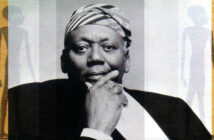
This page is also available in / Cette page est également disponible en:
![]() Francais (French)
Francais (French)
By now there are international days of just about everything, and surely one for every calendar date, even for that added one in leap years. While some are pretty obscure, others are common knowledge, for instance International Women’s Day, whose March 8 slot never goes by unnoticed, or falls on deaf ears for that matter.
But when it comes to the jazz world, women have long been undervalued for their contributions, the main reason being a lack of acknowledgement within the community at large, media and music lovers included. A significant step addressing this situation was taken late last year with the publication of a work that gives women their just due in the larger scheme of things.
There are several ways to know about the current state of affairs in jazz. One is to leaf through trade publications and look over festival lineups to see who the attention-getters are. Another is to glean critics and reader polls to find out which records keep popping up. Last but not least are the contentious issues that unleash heated debates, like the 1940s controversy that pitted classic jazz fans against the modernists of bebop, or mainstreamers taking to task the free-jazzers two decades later, followed by the surge of electric jazz in the Seventies and the backlash from diehard fans of acoustic music thereafter.
These days, the topic of gender inclusivity in arts and culture has never been more relevant. Women’s talents have been marginalized and suppressed throughout history in many sectors, and jazz is no exception. Now there is a responsibility to empower musicians who identify as female to continue creating and sharing their perspective, as these voices were seldom heard in the past. This responsibility must be felt from both the listener to seek new music, and influential industry leaders to support underrepresented creators. Through collaboration, it is possible for a more diverse jazz scene. And indeed, some women are taking control of their narrative and asserting their perspective in music.
One such musician is Terri Lyne Carrington. A drummer by trade, she is also a composer, teacher and social activist. This one-time Berklee College of Music student has been part of its teaching staff for many years now and in 2018 was named as the founder and artistic director of its newly established Berklee Institute of Jazz and Gender Justice.

Photo: M. Jackson
On the artistic side, this musical polymath embarked on something of an ambitious project over the last two years, one that finally saw the light of day late last summer. She took charge as chief editor of an anthology whose title is self-explanatory—New Standards: 101 Lead Sheets by Women Composers. This collection, or fake book as it’s known in the jazz trade, was released last September by Berklee Press in collaboration with Hal Leonard Publishers, a prominent editor of jazz scores and instruction manuals.
During the first post-pandemic run of the Montreal jazz festival in July 2022, Carrington appeared for three nights in its Invitation series, enabling this writer to meet her in person between two shows and get the scoop first-hand.
“I set my sights on 100 pieces for the book,” Carrington said, “and came up in the end with one more. The selections, I think, are significant as they span almost a century—the earliest written in 1922 by Lil Hardin, who was Louis Armstrong’s first wife; the most recent ones from a couple of my students. The project also involved some detective work, like digging out pieces by lesser-known or totally forgotten figures, the most obscure of them being Sara Cassey, a pianist active in Detroit till her death, far too young (at 37 in 1966).”
But there is more to it than the book. As a complement, Carrington entered the studio with a cast of name players to record 11 of the tunes, all of which appear on a recently issued recording (see record review section here). For Carrington, the downtime of the pandemic had a silver lining to it in that it allowed her to put in the time to pursue this project to its completion.
“Putting this book together was quite a bit of work, as you could imagine,” she said. “There are so many things to take care of in the process, like securing permissions from artists or their estates, copy editing, transcriptions of handwritten lead sheets and standardizing chord symbols. Also important was equal representation, which meant not exceeding two pages per piece—at times forcing us to compress some scores. At most you have pieces with three staves per system, but there are many with two, or just lead sheets with a single one.”
For lack of space, here is but a sample of names that will enable readers to appreciate the scope of this collection.
 Figures of the past: Mary Lou Williams, Alice Coltrane, Melba Liston, Abbey Lincoln, Geri Allen, Sara Cassey (the most obscure of them, discussed in one of the prefaces) and Jaimie Branch (who died unexpectedly late last summer).
Figures of the past: Mary Lou Williams, Alice Coltrane, Melba Liston, Abbey Lincoln, Geri Allen, Sara Cassey (the most obscure of them, discussed in one of the prefaces) and Jaimie Branch (who died unexpectedly late last summer).
Figures of the present: Maria Schneider, Carla Bley, Brazilian Eliane Elias, Cassandra Wilson, Marilyn Crispell, Myra Melford, Esperanza Spalding, Mary Halvorson Terri Lyne Carrington, Japanese-American Toshiko Akiyoshi, Swiss-born Sylvie Courvoisier and Israeli-born Anat Cohen, German-born Ingrid Laubrock..
Canadian contingent: The Jensen sisters (Ingrid and Christine), Renee Rosnes, Anna Webber, Kris Davis, Jane Bunnett and Marianne Trudel, the latter two not having followed suit of the others and remaining in the country rather than moving to New York.
Years after the publication of the Real Book in the 1970s (also at Berklee), this groundbreaking fake book remained the only work of its kind for aspiring jazzers—and a few pros as well—to turn to. Further editions have since appeared, expanded, corrected and improved in layout, but women remained vastly under-represented in all of them, to the point where you had to really search through the index to find some. These 101 pieces are welcome additions to the exponentially growing jazz repertoire, some of them hopefully becoming standard works in their own right someday.
Added values to this work are Carrington’s preface, two introductory essays on women in jazz, pieces grouped together under stylistic headings (blues, bop, contemporary, vocal, etc), a tune index at the back and another for composers, all of which enable performers, regardless of gender, to pick and choose as they so please. Vocalists have not been forgotten either, as there are a good dozen numbers with lyrics included. From beginner to advanced, this collection has something for all tastes. Everyone now to their music stands and play!
New Standards: 101 Lead Sheets by Women Composers / Berklee Press, 2022, ISBN 978-0876392232, 184 pp. + indexes
This just in: For her dedicated work as promoter and recording producer, Terri Lyne Carrington was granted just after the New Year a special Grammy Award, an honour she was just as surprised as thrilled to be awarded. Congrats TLC!
This page is also available in / Cette page est également disponible en:
![]() Francais (French)
Francais (French)













